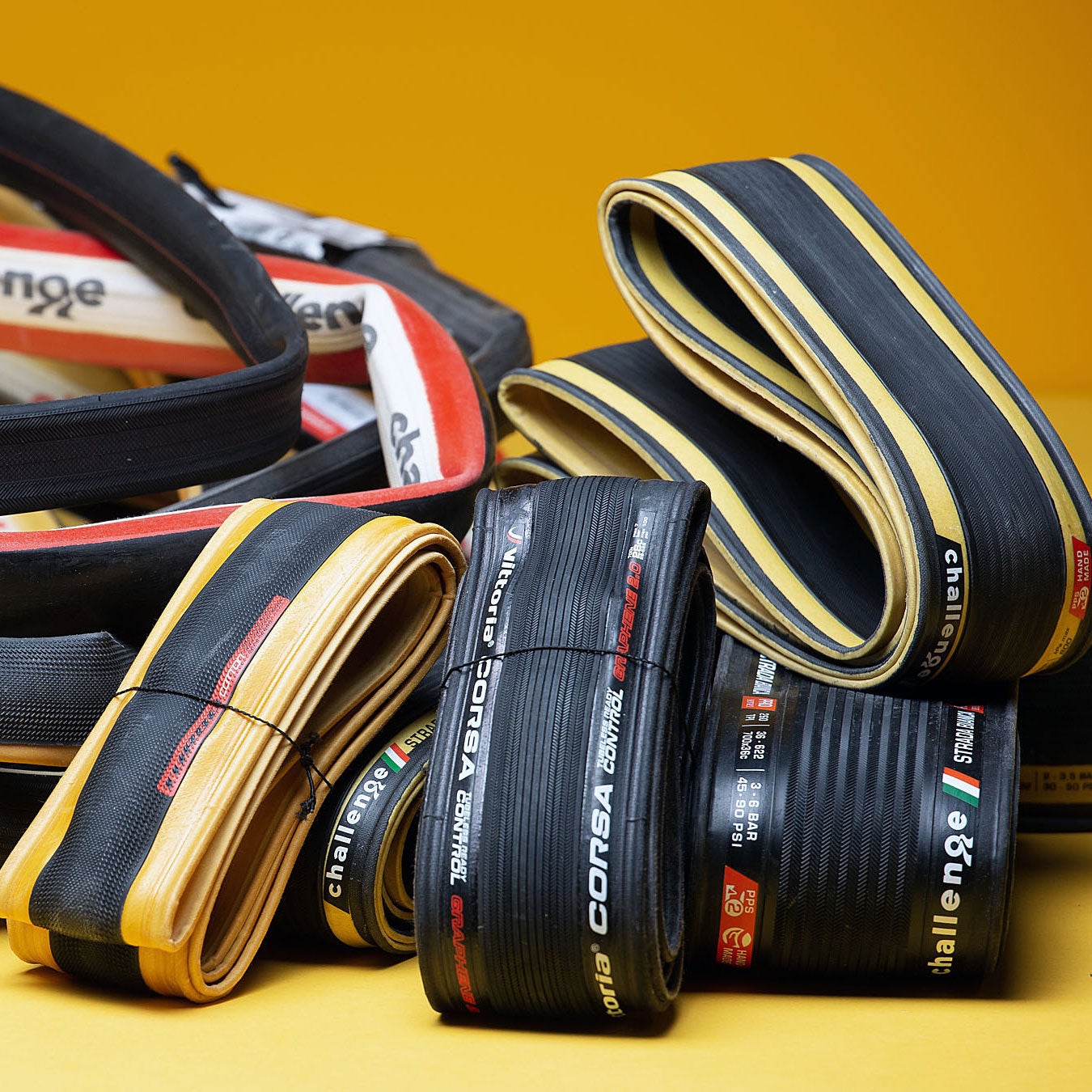Like clothing, cycling equipment is very much informed by trends. Also like clothing, most cycling trends involve a largely meaningless process of stuff getting wider or skinnier, higher or lower, looser or tighter. Just as necktie width expands and contracts, hemlines go up and down, and pant cuffs go from flared to tapered and back again, so too do handlebars and stems and frame geometries fluctuate according to the whims of the pros and the influencers and the marketing departments, as the case may be. Often there’s an ostensible reason for new equipment trends (increased performance, better handling, new styles of riding, etc.) but component selection quickly becomes a matter of fashion, which in turn hardens into rules, and then people simply adopt it without even thinking about it, until a new trend comes along and the cycle repeats itself.
No part of the bicycle is immune from the whims of fashion, and that includes tires. As the interface between your bike and the earth, tire selection is extremely important—but not so important that you can’t manage to totally overthink it. The current buzzword in bike tires is “suppleness.” Thanks in part to the popularity of gravel, coupled with , the idea is to max out on width, air down, and opt for a paper-thin casing that conforms to the terrain you’re riding like plastic wrap on a tuna sandwich. This in turn has led to unprecedented levels of fussing over air pressure, which is why you need a , and , and soon , Meanwhile, boutique tire brands flourish (the cult of being the most prominent), and it’s getting to the point where keeping your bicycles shod makes keeping a wine cellar seem cheap and unpretentious in comparison.
Overall, the increasing availability of supple, voluminous tires optimized for riding on irregular surfaces is a good thing, and if you do most of your riding on the sorts of hard-packed non-technical unpaved roads and trails the bike world now collectively files under the catch-all term “gravel” you’ll certainly appreciate them. However, just as toddlers drop their favorite toys as soon as you show them a new one, so do cyclists abandon the tried-and-true in favor of the newest-and-latest. In this case, many road cyclists are dropping firm and harder tires from the high chair, and that now seem hopelessly and pathetically outdated.
It wasn’t always this way; it’s just that right now we’re on the “soft and fat” portion of the tire timeline. For many years, the idea was that for optimum performance you wanted a narrow tire with high pressure, a flawed concept that hit its nadir in the late ‘80s when people rode around on 18mm rubber inflated to like 120PSI. (Even mountain bike tires were comparatively narrow, and plenty of frames back then could barely clear two inches.) Perhaps it’s the collective trauma and concomitant dental bills of running pinky-width tires that have caused us to swing so far in the other direction, which is understandable, since such tires really aren’t tenable beyond the wooden surface of an indoor velodrome. But some of the current “supple” offerings also decrease exponentially in tenability the further from the unpaved trail you get, and a tire that squirms under you when you’re climbing, or wanders when you corner, or has such a thin casing that you have no choice but to run it tubeless can be almost as annoying depending on how you ride.
Granted, it’s dangerous to compare bicycles with cars; that’s how you wind up with stuff like suspension and disc brakes. (Not to mention all those false equivalencies between cyclists and drivers.) Still, there’s at least an understanding in the automotive world that tire stiffness can be desirable if you’re looking for performance. Rolling resistance data is one thing, but that doesn’t account for the overall handling and road feel of the bicycle, and on pavement a supple tire can sometimes feel mushy and vague under spirited riding. (Unless you inflate the hell out of it, but then what’s the point?) Traction is crucial, and if your tire is too stiff you’ll lose it, yet excessive flex can also undermine your sense of control. The ever-increasing diameter of our handlebars and headtubes reflects this. In fact, they keep growing and growing, even though the performance bicycle cockpit has arguably been more than sufficiently stiff since the quill stem days. Yet a snappy millimeter tire–a “training” tire by 1980s standards–is now considered something obsolete that along with your primitive rim brakes and archaic cable-actuated shifters. (The upside of this is that they’re often on clearance, which means it’s now a bargain to experience the timeless joy of riding a lightweight, responsive, aerodynamic bicycle tire.)
Of course plenty of riders aren’t racing or particularly interested in pushing the limits of their equipment. Furthermore, skinny tires can be a thrill, but the vast majority of cyclists are far better served in terms of both comfort and safety by more tire volume and not less. Yet here too, a stiffer, more robust casing is an overall benefit–assuming volume is a constant, of course. As important as tires are to a bicycle’s ride characteristics, so too are geometry, and fit, and frame material, and other individual components such as saddles, handlebars, and grips. While a boutique supple tire may enhance the bike’s feel, a stiffer, heavier-duty tire won’t do much if anything to undermine it. A thicker tire with more puncture protection will also allow you to ride fuss-free from trail to road to glass-strewn gutter without having to go tubeless, which is often worth it if you need to run super low pressures off road, but can be more inconvenient than it’s worth for the rider who’s all over town and country over the course of a day.
For years the primacy of the road bike meant many riders were on narrower, harsher-riding tires than they needed to be. The ascendancy of gravel means now the average rider may be chasing a different yet equally inappropriate set of attributes. In my own shopping for all-around tires I’ve seen innumerable “gravel” tires with tan sidewalls and knobby tread I don’t need, though I’ve also found that the unsung heroes are often the unsexy models marketed as “touring” or even “city” tires–tough, long-lasting, and perfectly at home on most gravel surfaces you might encounter. Reflective strips aren’t as cool as tan sidewalls, but with bicycle tires the most boring choice can be the best one. Supple tires are an indulgence, like linen pants. But most of the time you’re better off in jeans.


